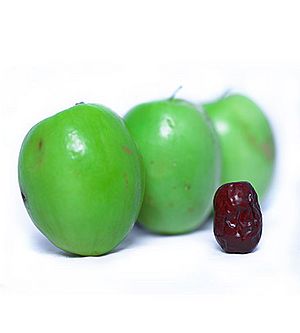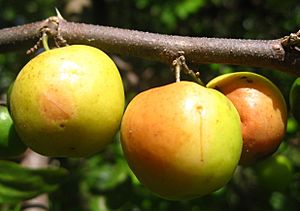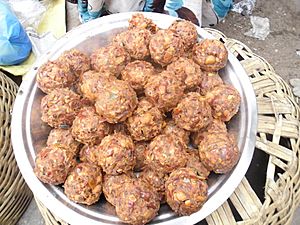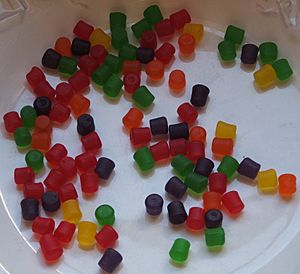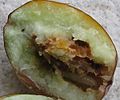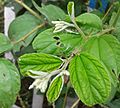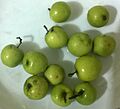Jujube facts for kids
Quick facts for kids Ziziphus jujuba |
|
|---|---|
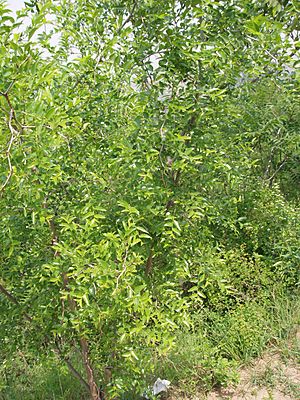 |
|
| Ziziphus jujuba | |
| Scientific classification | |
| Kingdom: | |
| (unranked): | |
| (unranked): | |
| (unranked): | |
| Order: | |
| Family: | |
| Genus: | |
| Binomial name | |
| Ziziphus jujuba |
|
The jujube (scientific name: Ziziphus jujuba) is a type of tree from the Buckthorn family. People mostly grow it for its fruit and for the shade it provides. Its strong, oily wood was used a long time ago to make woodcuts for printing the world's first books. This started in China in the 8th century and continued for hundreds of years. One jujube woodcut could even print up to 2000 copies!
Contents
Where Jujubes Grow
It's a bit tricky to know exactly where jujubes first grew naturally because people have been planting them for so long. But scientists think they originally came from southern Asia. This area includes places like Lebanon, northern India, and parts of China. They might have also grown in southeastern Europe, but it's more likely they were brought there by people.
Today, you can find jujubes in many places around the world. For example, they grow in Madagascar, where they are an invasive species in the western parts. In eastern Bulgaria, they are called "hinap" or "finab" and grow wild or in gardens. People there pick the fruit in autumn. Jujube trees also grow wild in the eastern Caribbean, including Jamaica, The Bahamas, and Trinidad.
Growing Jujube Trees
People started growing jujubes in south Asia as early as 9000 BC! There are now over 400 different types, or cultivars, of jujube plants. These trees are quite tough. They can handle many different temperatures and amounts of rain. However, they do need hot summers and enough water to produce good fruit.
Unlike many other trees in its family, the jujube can survive pretty cold winters. It can even live through temperatures as low as about -15°C (5°F). This means jujubes can grow in mountains or deserts, as long as they can reach water underground during the summer.
When a jujube fruit is young, it's green. As it gets older, it turns yellow-green and then gets mahogany-colored spots. A fully ripe jujube fruit is completely red. Soon after turning red, the fruit starts to get soft and wrinkly.
Eating Jujube Fruit
Fresh jujubes are often eaten as a snack. You can also find them dried and candied, which are popular with coffee. In Vietnam, people eat smoked jujubes, which they call black jujubes.
Both China and Korea make sweet tea syrups from jujube fruit, sold in jars. You can also find canned jujube tea or jujube tea in teabags. People also make jujube juice and even jujube vinegar. In West Bengal and Bangladesh, jujubes are used to make pickles. In China, they even make wine from jujube fruit!
In Vietnam and Taiwan, ripe jujubes are picked and sold in local markets. They are also sent to other Southeast Asian countries. Dried jujubes are used in desserts in China and Vietnam. One example is ching bo leung, a cold drink with dried jujube, longan, seaweed, barley, and lotus seeds. In Korea, jujubes are often used in teas. In Croatia, especially in a region called Dalmatia, jujubes are used to make jams, juices, and a type of fruit brandy called rakija.
In India, people traditionally dry the fruit in the sun and remove the hard seeds. Then, they pound it with tamarind, red chillies, salt, and jaggery (a type of sugar). In some parts of Tamil Nadu, fresh ripe jujubes are crushed with these ingredients and dried in the sun to make cakes. Jujubes are also a common snack there. In Madagascar, people eat jujubes fresh or dried, and they also make jam from them. In the Atlas Mountains of Morocco, a special jujube honey is made.
In Senegal, jujube is called Sii dem, and the fruit is eaten as a snack. The fruit is also turned into a dried paste that school kids enjoy. The commercial jujube candy you might find in movie theaters used to have jujube juice in it, but now it usually uses other flavors.
Medicinal Uses
The jujube fruit and its seeds have been used in Chinese and Korean traditional medicine for a long time. People believe they can help with stress. Traditionally, they were also used to help with fungal or bacterial problems, stomach ulcers, and inflammation. They were also thought to help wounds heal.
Images for kids
-
A drawing of Ziziphus jujuba from the book Flora de Filipinas
-
Jujube leaves in Hyderabad, India
-
Raw jujube fruit in Bangladesh
See also
 In Spanish: Jujube para niños
In Spanish: Jujube para niños


